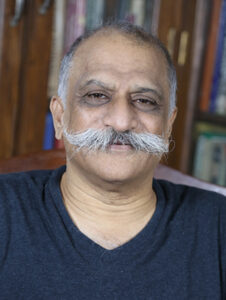
Shri P. Parameshwar Raju is a celebrated calligrapher and iconographer from Hyderabad, India. His love for handwriting and creating detailed icons has made him a standout in his field. From a young age, he developed a passion for aesthetics and dedicated himself to mastering different writing styles. Over time, he created a unique blend of traditional and innovative calligraphy that reflects his personal touch.
His fascination doesn’t stop at calligraphy; he also dove into iconography, exploring ancient methods for crafting religious imagery. His artworks beautifully combine calligraphy and iconography, weaving sacred verses and symbols together to give them deep meaning. Thanks to his incredible talent, he has gained recognition around the world, with numerous exhibitions and awards showcasing his skills.
But it doesn’t end there! Shri Parameshwar Raju is also a dedicated teacher who shares his knowledge through workshops, inspiring aspiring artists to pursue their passion. His commitment to excellence and preserving traditional arts has made him a respected figure in the artistic community.
Our team was eager to learn more about his journey and experiences, and we asked him a few questions to gain insights into his incredible work.
Could you tell us a bit about your background and journey with us?
Since the age of ten, I have been practising calligraphy by writing alphabets in Devanagari. My father was keen on instilling discipline in me and ensuring that I wrote with clarity and a touch of flair. My teacher, Sri Rama Varma, taught me the basics at Sainik School Amaravatinagar in Tamil Nadu. He would always demonstrate first and then have us practice. Under his guidance, I not only learned writing but also explored poster making, painting, and drawing.
Growing up, my father, Lt Col Dr Poosapati Appala Raju, served in the Army, which meant frequent transfers and living in different parts of the country. We resided in Madhya Pradesh, Tamil Nadu, Maharashtra, Garhwal, Uttar Pradesh, Gujarat, Punjab, and Andhra Pradesh. These experiences exposed me to diverse traditions, vibrant festival celebrations, captivating art and crafts, mouth-watering cuisine, and a multitude of languages from various regions of our beloved country.
Can you share any memories or experiences from your childhood that ignited your passion for art?
My grandfather, Poosapati Raghava Raju, was a remarkable and multi-talented person. He knew how to sculpt with various materials, such as clay, wood, and metal. The tradition of creating Clay Ganesha idols for Ganesh Chaturthi is a widely practised custom, and my grandfather’s creativity for this annual celebration highlights his dedication to his craft and his commitment to preserving cultural traditions. His clay Ganesha sculptures made a lasting impact on me at a young age, fostering my respect for traditional art and crafts.
Furthermore, my grandfather’s proficiency in taxidermy showed his ability to work with diverse materials and techniques. Taxidermy requires a deep understanding of anatomy, preservation methods, and artistic skills to create lifelike representations of animals. It was fascinating to note that he was skilled in this field as well.His involvement in treating ailments with Homeopathy and Ayurveda points to his interest in alternative medicine and holistic healing practices. This indicates his well-rounded knowledge and his desire to help others through different modalities.
Largely, my grandfather’s diverse skills and talents across various artistic and healing disciplines reflect his passion for creativity, culture, and well-being, and left a deep impression on me.
How did your upbringing or cultural background shape your artistic perspective, especially about religious themes and iconography?
My upbringing and cultural background have significantly shaped my artistic perspective, especially in relation to religious themes and iconography. Growing up in diverse India allowed me to experience a rich tapestry of religions, each with its unique traditions and artistic expressions.
Living in different regions exposed me to a variety of religious practices. From the vibrant festivals of Gujarat to the majestic temples of Tamil Nadu and the serene gurdwaras of Punjab, each place offered its distinct visual language and iconography. This exposure deepened my appreciation for the ways in which art and spirituality intertwine.My parents and teachers emphasized the importance of respecting and understanding various beliefs, encouraging me to explore and learn about different faiths. This guidance fostered a sense of curiosity and admiration for religious art, symbolism, and the stories they convey.
As I delved into calligraphy and artistic expression, I found inspiration in the intricate designs of Hindu scriptures, the elegance of Islamic calligraphy, and the vibrant colors of Buddhist thangka paintings. These influences, combined with my creative engagement, have shaped my artistic perspective to honor and celebrate the diverse religious traditions of India.
In my work, I strive to create a balance between tradition and innovation. I draw inspiration from the rich heritage of epics and Puranas while incorporating my unique style to express these narratives visually. Through my art, I aim to reflect the beauty and depth of India’s spiritual landscape.

As an iconography artist, what drew you to this unique form of artistic expression, and how has it influenced your spiritual and creative journey?
Crafting each detail, selecting an appropriate palette, and capturing the essence of a narrative requires a deep level of focus and contemplation. This process can be time consuming but is transformative, fostering a sense of connection with the concept and deepening my creative journey.
In terms of my creative journey, when I was initially writing Devanagari, I concentrated on the pictorial possibilities of Aum and, from then on, depicted iconography in the form of Aum. This experimentation with form has impacted my artistic approach in numerous ways. It has honed my attention to detail, as accuracy and precision are crucial in portraying narratives, symbols and iconography. The study of iconography has also expanded my knowledge of traditions, symbolism, and mythology, which in turn enriches my creative palette and allows for more nuanced and layered artistic expression.
Can you share some insights into the process of creating religious icons? What are the key elements you consider when capturing the essence of a religious figure or scene?
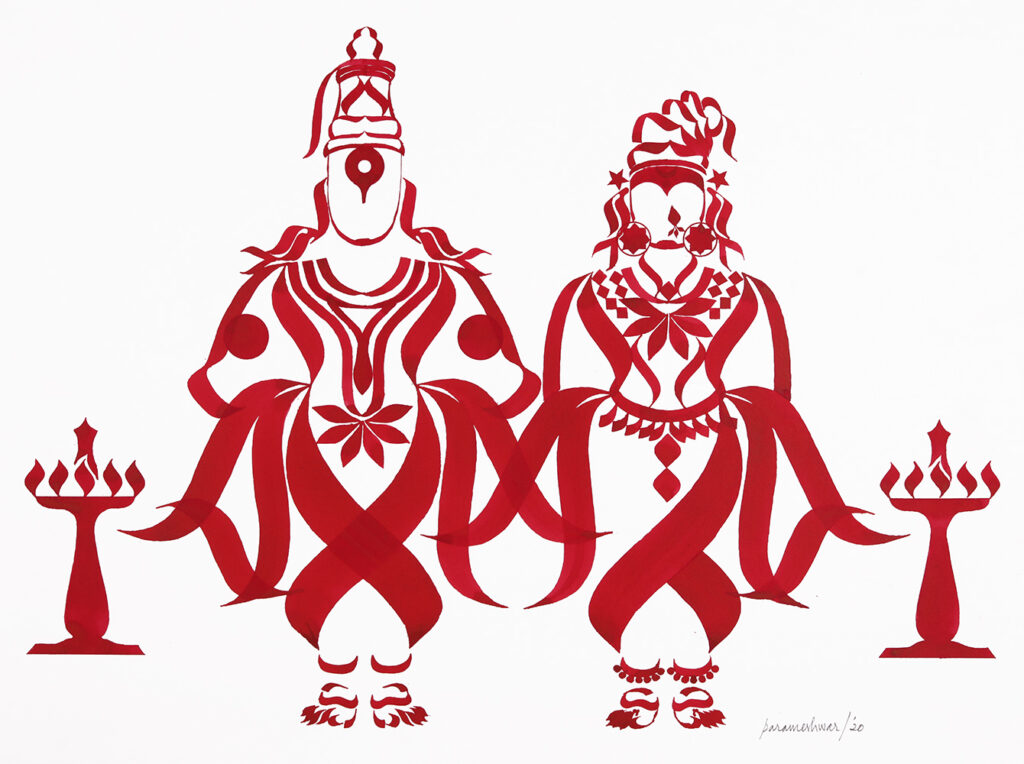
Engaging with Iconography is solely an artistic endeavour for me. My calligraphic practice is a complete experience in itself. The artist must approach the creation of icons with an understanding of the significance and purpose behind their work. This intention infuses the artwork with dynamism and helps establish a connection between the viewer and the artist. For a better understanding of the role of intent, let me give the example of a Sculptor or a designer – how they would reflect only on the aesthetics while creating a Ganesha figure while the priest would chant the Ganesha Atharvashirsha to invoke the same idol. In this case, the intent and role of the sculptor/artist/designer and the priest are completely different.
How do you approach the challenge of translating spiritual concepts and symbolism into visual representations in your iconography work?
As an artist, my intention plays a crucial role in shaping my work. I see my art as a blend of various elements—pictorial representations that utilize calligraphy to create original, painterly compositions. Through my study of iconography, I’ve deepened my understanding of traditions, symbolism, and mythology, which enriches my creative palette and allows for more nuanced artistic expression.
Before I visually represent a spiritual concept, I invest time in thorough research. I dive into religious texts and learn about the cultural contexts and beliefs tied to the ideas I’m exploring. This foundational knowledge is essential to my creative process. I pay particular attention to symbolism, identifying key motifs—sacred objects, gestures, colors—that resonate with the concepts I want to express.
For me, art often transcends the physical realm. I explore metaphors that encapsulate abstract ideas, bridging the spiritual and the visual. My series on divine presence, for instance, beautifully illustrates this: the pair of feet adorned with attributes of the gods not only symbolizes their power but also brings to life the metaphor of divine presence in our lives.
Emotion is another vital aspect of my work. I aim to capture the feelings and cultural connections associated with these spiritual concepts, carefully considering color palettes, composition, and light to evoke the right mood.
While I honor traditional iconography, I also believe in infusing my own creative interpretation. This balance allows for innovation while preserving the integrity of the original concepts. Ultimately, my goal is to create artwork that resonates deeply, inviting viewers to connect with the rich tapestry of spiritual meaning behind each piece.



Your published religious books have likely reached and inspired many readers. Can you discuss your experience in creating motifs and visuals for the same?
My books are appreciated by many viewers. Publishing religious books is not my intention. But communication is an important part of my work as I wish to communicate epic narratives in my pictorial calligraphy.
Motifs and visuals are part of my visual engagement. I don’t create motifs and visuals for my book. Artists are known to catalogue their work in the form of a book, plates or portfolio.
Creating motifs and visuals for any artistic project involves a combination of artistic vision, creativity, and effective communication. Here are some aspects to consider:
Understanding the Message: The first step is to have a clear understanding of the message or theme that the motifs and visuals need to convey. This involves studying the religious text or concept and identifying key symbols, themes, and narratives that are relevant.
Research and Inspiration: Conducting research and seeking inspiration from various sources can help in developing a visual vocabulary for the project. This may involve studying and exploring cultural symbolism or delving into specific traditions to gain insights and ideas.
In your opinion, what makes an icon or illustration resonate deeply with viewers, and what role does symbolism play in creating a meaningful connection?
The intention of an artist plays a significant role in defining their art. My works are pictorial, in the medium of calligraphy, original compositions and painterly to a great degree because of the way I work. My images are a combination of many elements. They are forms and images but not illustrations. While illustration typically aims to depict or represent something specific; abstract minimal forms focus more on expression and evoke emotions or convey ideas through visual elements such as shapes, lines, and colours. The emphasis is on aesthetic expression rather than on literal representation. Abstract art often allows for multiple interpretations and encourages viewers to engage with the artwork on a more subjective and emotional level. It is through this expressive quality that abstract minimal forms can communicate and evoke powerful responses from the audience.
I exhibited the story of Jesus in the Metropolitan Gallery in New Delhi, at the Museum of Sacred Art in Belgium, and at Gallery Ashok in Amsterdam. Visitors from Asia, the Middle East, Europe and Americas came to see the show and in all these events, it took very little time for viewers to identify the forms. They became emotional and conversational while looking at the paintings.
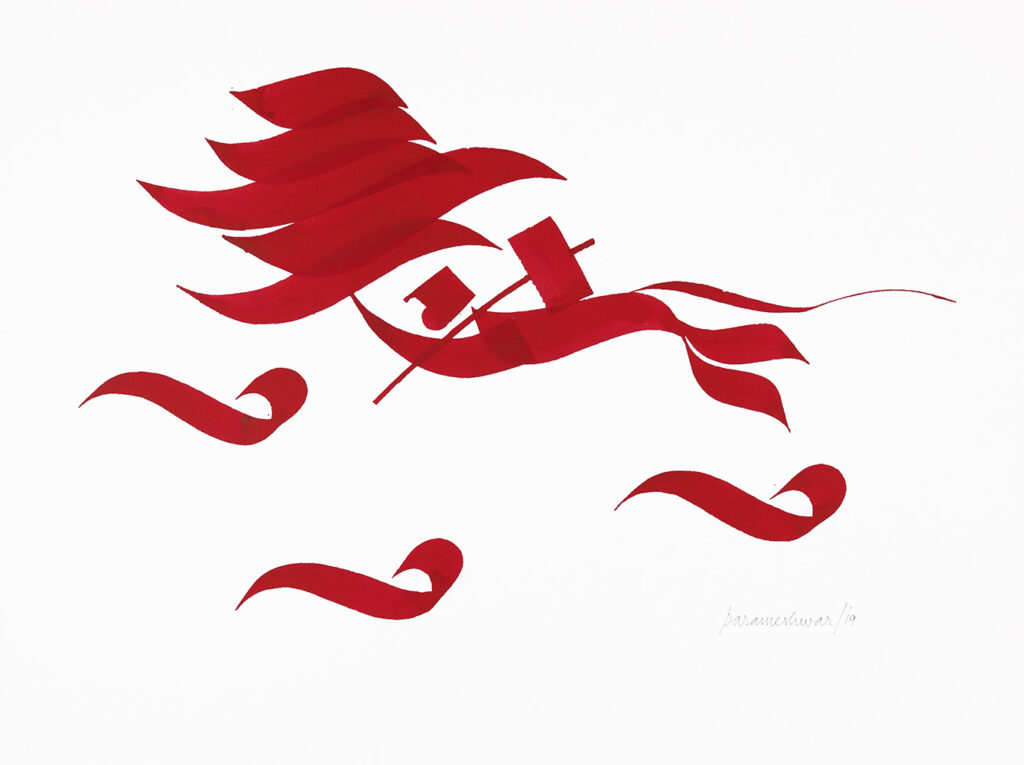
The history of religious iconography is rich and diverse. How do you incorporate traditional techniques and styles into your artwork, while also adding your unique artistic voice and interpretation?
I challenge myself to do everything within the rudiments of traditional calligraphy, by expressing anything and everything with the thin-thick-thin lines. The power of the rhythmic thin-thick-thin lines intrigued me, breathing life into the forms I created. Soon I identified this sequence of life and its continuity; life-continuity-end and back to life, as a natural rhythm. The red colour is the Shakti held by the white space – Shiva.
In the current digital era, how do you keep yourself attached and motivated towards pursuing your traditional craft, something that has been handed over to you for generations?
I found my expression idiosyncratic to my way of thinking in doing things differently. No one handed over anything to me. However, I was made aware of the traditional information about ancient Indian Sthapatya Vidya and yantras by my Grandfather Sri Poosapati Raghava Raju. I became aware of how Indian Culture and heritage can not be experienced within a colonial framework. I continue to research to create a deeper understanding that all aesthetic objects are reflections of the universe in the traditional Indian space division.
Moreover, I use updated versions of design software to convert my drawings to vectors so that they could be adapted in other mediums such as textile, metal, wood, and jewellery for my limited edition creations.
How do you keep yourself informed about the newest tools and trends in calligraphy?
As a designer, I try to be always abreast of my time as I closely follow the latest trends and tools. However, for my calligraphy practice, I work with traditional tools, keeping an eye on the best ink and paper to enjoy my daily practice. The content of my work follows my inner response to societal changes and makes my work more dynamic in an academic sense. The Girl Child Series is an example wherein the central character is the girl child who is nurtured with education & skills and finally, she evolves as a confident and responsible woman contributing to society. This engagement has nothing to do with following a new trend but being sensitive to the changes in society and creating an impact in the minds of the viewer.
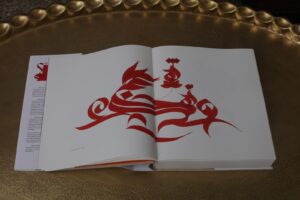
Publishing religious books requires a combination of artistic vision and effective communication. Can you discuss your approach to designing and illustrating these books to ensure they convey intended messages and resonate with readers?
Publishing, designing and illustrating religious books – these are not my intentions. But communication is an important part of my work as I wish to communicate epic narratives in my pictorial calligraphy. I make painstaking efforts to keep the characters uniform. I intend to stick to an academic calligraphy practice. My books are also a part of the same approach to academically articulate each of my series. However, the magic of our traditional epic narratives, sacred symbols and iconography gets conveyed to the viewers irrespective of the barriers of cultural differences. Asians, Americans, Europeans, or anyone of any age can read the images and understand the storyline and its sequence. The taxonomy also guides the viewers to follow the narrative in the exhibits.
Tell us about the books you have published so far and which was the first book you have published.
Guileful Strokes was my first book; it is a compilation of 100 images of my work.
Later, twenty books were published, each one of which discusses a particular series. The Benign Perch, The Bliss of Being, Aum, Shiva, Panchabhuta Lingas Jyotir Linga, Lakshmi, Shakti, Divine Presence, Navadurga, Ganesha, Ashta Vinayaka, Panchayatana, Surya, Krishna, Anjaneya, Ramayanam, Gurus and Avataras, Radiant Flow, Ashtamangala – Jain and Buddhist symbols, The Story of Jesus and many more. All of the books are researched and articulated by Art Historian, Koeli Mukherjee Ghose. Currently, all of these books are being compiled to make two volumes which are set to be published in 2023.
We would love to know more about your recent project, Ramayana Kalpavrksam. What is it inspired by and what was your creative process behind the project?
Ramayana Kalpavriksham is the first-ever festival to celebrate Ramayana in its various forms. It was conceived by Padmashri Ananda Shankar in Hyderabad. It involves artistic expression from artists in many disciplines like dance, classical music, art, puppetry, discourse, Nagarasankirtana, storytelling, fusion music, among others. I was invited to present my works on the Ramayanam. I exhibited fifty-four frames, completing the entire story of Ramayanam – from Siva narrating Ramayanam to Parvati to Rama submerging himself in the River Sarayu.
The entire narrative is in pictorial form. At first glance, what may seem like a written word soon starts taking shape as a human form with a diamond-shaped stroke forming the head of a masculine character and a round-shaped head denoting a feminine character. The two masculine forms with bows depicted Rama and Lakshmana while the feminine form with a flower tucked in the coiffure was that of the Sita. In this manner, each character had a distinct feature that made them conspicuous. The Hanuman seated on his tail, coiled and raised high in Ravana’s court was recognisable as was Ravana with his ten heads, Manthara with a hunched back, Kumbhakarna in resupine position with drummers around him trying to wake him up, and King Guha in his boat, ferrying Rama, Sita and Lakshmana across the Sarayu river at the beginning of Rama’s exile.
The characters are performative even though the forms and the nomenclature of the art are minimalistic. The viewers experience the enactment of the great epic Ramayanam unfold gradually in each frame, keeping true to my theoretical context that the stories of the past from the Puranas are enacted in my art as a sequence of events, in which the viewers partake. The viewers experience the visual magic of soul-stirring compositions of spiritual masters that empower us with strength and beauty.
We see that you use red ink in most of your artwork. What is its philosophical significance in your tradition?
Red symbolises material life, and white symbolises spiritual life, as in the Kumkum anointments and the Bhasma namams. In my work, the interplay of red characters on the white paper is metaphorical to this philosophy.
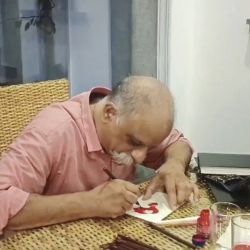
What guidance would you offer to aspiring artists looking to integrate visual art into their practice?
To enjoy every bit of their practice and use good material for good results as this keeps the motivation high. Avoiding plagiarism is something they should be aware of. In contemporary times plagiarism in art is the worst experience for visual artists as often than not they are faced with the horrific experience of their work getting copied and used without any monetary compensation or acknowledgement.


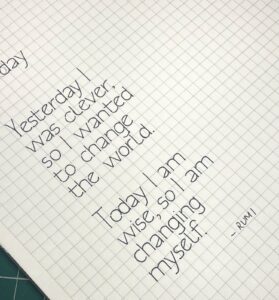
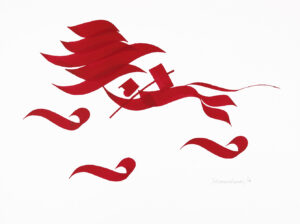
1 thought on “An Exclusive Interview with Shri P. Parameshwar Raju: Exploring Calligraphy and Iconography”
This interview was good read. Insightful content.